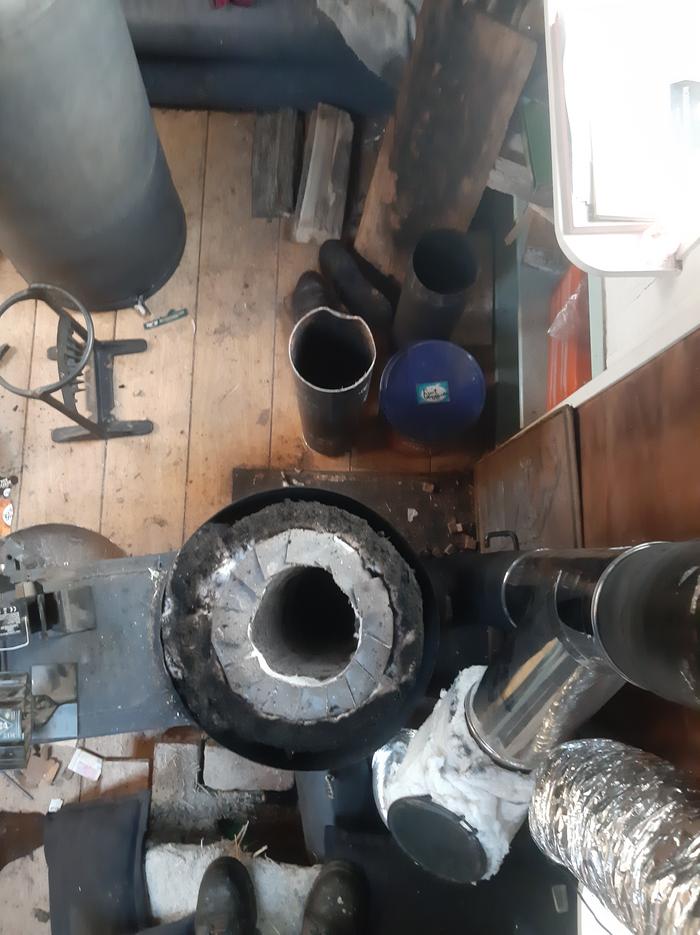
 1
1





 2
2




For all your Montana Masonry Heater parts (also known as) Rocket Mass heater parts.
Visit me at
dragontechrmh.com Once you go brick you will never go back!








For all your Montana Masonry Heater parts (also known as) Rocket Mass heater parts.
Visit me at
dragontechrmh.com Once you go brick you will never go back!




 1
1




thomas rubino wrote:Hi Fraser; How is the smoke coming out the chimney? Steam? Heat shimmers? Or grey black smoke?
It is possible that is caused by the still wet cob .... But
That looks like over fueling to me.
Over fueling is a phenomenon that happens with batch box's.
It is common for a hot batch to over fuel directly after adding new wood .
It should only do that for a few minutes before clearing up.
What size is your primary air inlet and what size is your secondary air inlet?
Are they a combined air or separate?
Total air input is apx. 20% of riser size.
 1
1








 4
4




For all your Montana Masonry Heater parts (also known as) Rocket Mass heater parts.
Visit me at
dragontechrmh.com Once you go brick you will never go back!
 1
1








 2
2




For all your Montana Masonry Heater parts (also known as) Rocket Mass heater parts.
Visit me at
dragontechrmh.com Once you go brick you will never go back!

 3
3





God of procrastination https://www.youtube.com/watch?v=q1EoT9sedqY
 5
5




regards, Peter
 3
3




 4
4




regards, Peter





God of procrastination https://www.youtube.com/watch?v=q1EoT9sedqY









 1
1




fraser stewart wrote:Sorry guys but what is meant by csa.
I guess cubic surface area?
God of procrastination https://www.youtube.com/watch?v=q1EoT9sedqY
 1
1




fraser stewart wrote:I made the secondary air intake a while ago. I think its based on peters sketch up model measurments Tonight i will take it out and measure it and post it..
regards, Peter
 1
1












 4
4




For all your Montana Masonry Heater parts (also known as) Rocket Mass heater parts.
Visit me at
dragontechrmh.com Once you go brick you will never go back!
















Glenn Herbert wrote:That is a lot of metal radiating surface area. The duct from manifold to bench is the smallest part. You haven't mentioned the internal surface area of the whole system other than "based on Peter's specs for 15cm" (6"). How does that compare with the recommended ISA for the size of your batch box system? I would be concerned that you might have too much ISA and drawing too much heat, so that there is not enough left to warm the whole bell.








 1
1




For all your Montana Masonry Heater parts (also known as) Rocket Mass heater parts.
Visit me at
dragontechrmh.com Once you go brick you will never go back!




thomas rubino wrote:Hi Frasier; Your air channel can be repaired. Simply cut off the old stub and weld on a replacement.
If you were in the states I would recommend a RA330 stub. Installed 8" tall. After 2.5 years of hard long burning. Matt walker has inspected his and there is no degradation at all.
It is showing the potential to be a very long term part, making the upfront costs much lower when amortized over many years.
I am selling these here in the states,(dragontechrmh.com) but shipping to the Netherlands I imagine would be very expensive.




 1
1




For all your Montana Masonry Heater parts (also known as) Rocket Mass heater parts.
Visit me at
dragontechrmh.com Once you go brick you will never go back!

 1
1




 1
1




fraser stewart wrote:I am thinking of insultating more of my barrel as i would like towarm the mass better. What do you guys think. Would you recommend it?
Silence is Golden
For all your RMH needs:
dragontechrmh.com




Glenn Herbert wrote:ISA is internal surface area. You can get the proper sizing information at batchrocket.eu.
 1
1




fraser stewart wrote:I have read it a few time. Im not sure how you come by 0.0176715 sq m
regards, Peter




Peter van den Berg wrote:
fraser stewart wrote:I have read it a few time. Im not sure how you come by 0.0176715 sq m
I had lots of difficulties to grap the concept of decimal calculation while in primary school.
The 150 mm diameter is equivalent to 15 cm, 1.5 dm or 0.15 m. The formula to calculate the area of a circle is pi R², isn't it? That makes the cross section area of a pipe with that diameter 17671.5 mm², 176.715 cm², 1.76715 dm² or 0.0176715 m², all the same but expressed in a different value. The decimal point shifts one place for lengths, two places for area (²) and three for volume (³) when transposing up or down one step. So, going up three steps from millimeter to meter for area is the same as deviding by 1000000.
Once the teacher explained the above rules to this little boy it started to dawn on me. Sufficient to say, I wasn't a quick learner back then.[/quote
Thanks peter. I was not as attentive in class as you were. Or my treachers never made it so clear as you just did.
Learning each step of the way.
From your text on your website i gather that it is the surface area in cm combined that give you your ideal bell size. So the surface of the barrel around the heat riser and the surface of the barrels in the stratification chamber and the floor. These combined should be the values given in your table. Is that correct?






|
Gravity is a harsh mistress. But this tiny ad is pretty easy to deal with:
Play Your Way to a Sustainable Lifestyle: Uncover Permaculture Principles with Each Card
https://gardener-gift.com/
|





